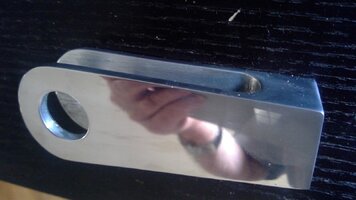I finally had a win. Initially I made the adjuster with a 15mm slot to fit over the swingarm axle mounts. That didn't work too well, scratched the hell out of the paintwork. Next I tried putting a step in the slot, 15mm where the axle slips through and 16mm for the rest, but couldn't get a decent finish inside the slot. I know you can't see inside the slot when it's fitted, but, I know the finish isn't up to scratch. So today I milled the slot out to 16mm for the whole length, papered it reasonably smooth, then put it in the vice and stepped it by bending the ends in to around 15.5mm. Seems to work pretty well, so I'll try making another tomorrow the same way. I think I'm going to have to powder coat the frame though, the acrylic lacquer just scratches and chips too easily.
Attachments
Last edited:


